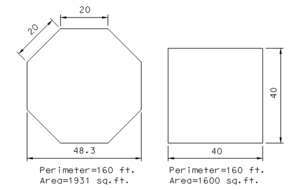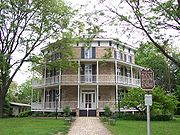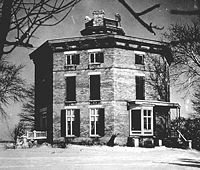
Octagon house
Encyclopedia
_2.jpg)
Floor plan
In architecture and building engineering, a floor plan, or floorplan, is a diagram, usually to scale, showing a view from above of the relationships between rooms, spaces and other physical features at one level of a structure....
, and often feature a flat roof and a veranda all round. Their unusual shape and appearance, quite different from the ornate pitched-roof houses typical of the period, can generally be traced to the influence of one man, amateur architect
Architect
An architect is a person trained in the planning, design and oversight of the construction of buildings. To practice architecture means to offer or render services in connection with the design and construction of a building, or group of buildings and the space within the site surrounding the...
and lifestyle pundit Orson Squire Fowler
Orson Squire Fowler
Orson Squire Fowler was a phrenologist who popularized the octagon house in the middle of the nineteenth century....
. Although there are other octagonal houses worldwide, the term octagon house usually refers specifically to octagonal houses built in North America during this period, and up to the turn of the century.
History
Early examples, before Fowler:- Poplar ForestPoplar ForestPoplar Forest was Thomas Jefferson's plantation and plantation house in what is now Forest, Virginia, near Lynchburg. He designed it and treated it as a private retreat, working on it from 1806 until his death 20 years later. "It is the most valuable of my possessions," Jefferson once wrote a...
, Thomas JeffersonThomas JeffersonThomas Jefferson was the principal author of the United States Declaration of Independence and the Statute of Virginia for Religious Freedom , the third President of the United States and founder of the University of Virginia...
's private retreat and plantation house near Lynchburg, Virginia. - William ThorntonWilliam ThorntonDr. William Thornton was a British-American physician, inventor, painter and architect who designed the United States Capitol, an authentic polymath...
's Tayloe House, more commonly called The Octagon HouseThe Octagon HouseThe Octagon House, also known as the Colonel John Tayloe III House, is located at 1799 New York Avenue, Northwest in the Foggy Bottom neighborhood of Washington, D.C.-History:...
in Washington, DC. After the White HouseWhite HouseThe White House is the official residence and principal workplace of the president of the United States. Located at 1600 Pennsylvania Avenue NW in Washington, D.C., the house was designed by Irish-born James Hoban, and built between 1792 and 1800 of white-painted Aquia sandstone in the Neoclassical...
was burned by the British during the War of 1812War of 1812The War of 1812 was a military conflict fought between the forces of the United States of America and those of the British Empire. The Americans declared war in 1812 for several reasons, including trade restrictions because of Britain's ongoing war with France, impressment of American merchant...
, PresidentPresident of the United StatesThe President of the United States of America is the head of state and head of government of the United States. The president leads the executive branch of the federal government and is the commander-in-chief of the United States Armed Forces....
James MadisonJames MadisonJames Madison, Jr. was an American statesman and political theorist. He was the fourth President of the United States and is hailed as the “Father of the Constitution” for being the primary author of the United States Constitution and at first an opponent of, and then a key author of the United...
stayed in the Octagon House, and it was here that the Treaty of GhentTreaty of GhentThe Treaty of Ghent , signed on 24 December 1814, in Ghent , was the peace treaty that ended the War of 1812 between the United States of America and the United Kingdom of Great Britain and Ireland...
(ending the War of 1812) was signed. It is now the headquarters of the American Institute of ArchitectsAmerican Institute of ArchitectsThe American Institute of Architects is a professional organization for architects in the United States. Headquartered in Washington, D.C., the AIA offers education, government advocacy, community redevelopment, and public outreach to support the architecture profession and improve its public image...
.
Both houses are large brick buildings in the classical tradition. They may be seen as precursors, but are somewhat different from the Victorian octagon houses which are essentially domestic structures.
Orson Squire Fowler
The leading exponent of octagonal houses was Orson Squire Fowler. Fowler was America's foremost lecturer and writer on phrenologyPhrenology
Phrenology is a pseudoscience primarily focused on measurements of the human skull, based on the concept that the brain is the organ of the mind, and that certain brain areas have localized, specific functions or modules...
, the pseudoscience
Pseudoscience
Pseudoscience is a claim, belief, or practice which is presented as scientific, but which does not adhere to a valid scientific method, lacks supporting evidence or plausibility, cannot be reliably tested, or otherwise lacks scientific status...
of defining an individual's characteristics by the contours of the head. In the middle of the 19th century, Fowler made his mark on American architecture when he touted the advantages of octagonal homes over rectangular and square structures in his widely publicized book, The Octagon House: A Home For All, or A New, Cheap, Convenient, and Superior Mode of Building, printed in the year 1848. As a result of this popular and influential publication, a few thousand octagonal houses were erected in the United States, mostly in the Midwest, the East Coast
East Coast of the United States
The East Coast of the United States, also known as the Eastern Seaboard, refers to the easternmost coastal states in the United States, which touch the Atlantic Ocean and stretch up to Canada. The term includes the U.S...
and in nearby parts of Canada
Canada
Canada is a North American country consisting of ten provinces and three territories. Located in the northern part of the continent, it extends from the Atlantic Ocean in the east to the Pacific Ocean in the west, and northward into the Arctic Ocean...
.
Advantages of the octagon plan

Degree (angle)
A degree , usually denoted by ° , is a measurement of plane angle, representing 1⁄360 of a full rotation; one degree is equivalent to π/180 radians...
corners, as in the typical bay window
Bay window
A bay window is a window space projecting outward from the main walls of a building and forming a bay in a room, either square or polygonal in plan. The angles most commonly used on the inside corners of the bay are 90, 135 and 150 degrees. Bay windows are often associated with Victorian architecture...
, and could easily adapt to an octagonal plan.
Design principles
Fowler's The Octagon House is sometimes incorrectly referred to as a pattern book but the popularity of the book lies in the way Fowler suggested some general principles, and encouraged readers to invent the details for themselves. Only a few examples are offered, and apart from plans, the book has only two illustrations to show how an octagonal house might look.First, he shows some ways of subdividing an octagonal floor plan. Next is Howland's octagonal plan, a small house designed by 'Messrs. Morgan and Brothers, architects' which is similar to the Norrish House
Norrish House
The Claflin-Norrish House is an octagonal house in Hastings, Minnesota, part of the West Second Street Residential Historic District. The two-story home was built of limestone covered with stucco. Special features include a windowed cupola and wrap-around porch. It still stands at Spring and West...
illustrated below. There follows A description of the author's own residence, now known as Fowler's Folly
Fowler's Folly
Fowler's Folly, built during 1848-1853, was the octagonal home of Orson S. Fowler in Fishkill, New York. It was a "monumental" house for its time, with 4 stories and 60 rooms. Fowler first published his book, The Octagon House: A House for All in 1848....
, at Fishkill, of which more below. Finally, A superior plan for a good sized house, which is a development of the Fishkill plans, apparently proposed by his engraver. The main feature of his plans is a desire to eliminate unnecessary circulation space, sometimes to the point that the main staircase in inconvenient, and the external veranda is the best way to get around the house. Fowler was not an architect and in some ways, his theories needed an architect to bring them to a workable conclusion.
Other design proposals include:
- Flat roof to collect rainwater, with cisternCisternA cistern is a waterproof receptacle for holding liquids, usually water. Cisterns are often built to catch and store rainwater. Cisterns are distinguished from wells by their waterproof linings...
s built-in to collect and distribute the water. - Rainwater filtering, using filter beds made up of alternating layers of sand and activated charcoal.
- Central heating by distributing hot air from a furnaceFurnaceA furnace is a device used for heating. The name derives from Latin fornax, oven.In American English and Canadian English, the term furnace on its own is generally used to describe household heating systems based on a central furnace , and sometimes as a synonym for kiln, a device used in the...
in the basementBasement__FORCETOC__A basement is one or more floors of a building that are either completely or partially below the ground floor. Basements are typically used as a utility space for a building where such items as the furnace, water heater, breaker panel or fuse box, car park, and air-conditioning system...
. - Flues, air ducts and speaking tubeSpeaking tubeA speaking tube or voicepipe is a device based on two cones connected by an air pipe through which speech can be transmitted over an extended distance. While its most common use was in intra-ship communications, the principle was also used in fine homes and offices of the 19th century, as well as...
s built into the thickness of walls.
Built examples vary greatly in how much of this influence is apparent. Although built in brick, the Watertown house featured in this article is an almost perfect embodiment of many of Fowler's ideas.
Concrete construction
The third edition of Fowler's book, printed in 1853, has a new subtitle: A Home For All, or The Gravel Wall and Octagon Mode of Building, and was distinguished by Fowler's enthusiasm for concrete construction. He appears to be unaware that concrete has been in use since the Romans, attributing the discovery to a Mr Goodrich of Jaynesville, Wisconsin, and crediting himself with developing and popularizing the technique. Fowler knew gravel and lime were available in unlimited quantities in the prairies and saw the "gravel wall" as offering a new, cheap and durable way of building. His house at Fishkill was built in concrete. The walls were built up a few feet at a time, by pouring a mixture of gravel and lime into timber shuttering. As the concrete cured, the shuttering could be taken down and moved up to the next level.Modern concrete is made using Portland cement
Portland cement
Portland cement is the most common type of cement in general use around the world because it is a basic ingredient of concrete, mortar, stucco and most non-specialty grout...
, not lime, but the main difference is the universal use of steel reinforcing bars, which greatly increase the strength of the material, and make it possible to build concrete beams and floor slabs as well as walls. Fowler used large stones to reinforce corners, but he used no other reinforcement, and was therefore restricted to walls. The roof, floors and verandas are therefore all of timber construction.
Fowler's Folly
To quote Fowler "...those studies which have eventuated in this work were instituted primarily in order to erect this very house". Construction began in 1848, the same year his book was first published, and took five years to complete. The house was large, 42 foot to each side of the octagon or 100 feet across, and built on a hilltop overlooking the Hudson RiverHudson River
The Hudson is a river that flows from north to south through eastern New York. The highest official source is at Lake Tear of the Clouds, on the slopes of Mount Marcy in the Adirondack Mountains. The river itself officially begins in Henderson Lake in Newcomb, New York...
, where it could be seen for miles around. Fowler removed the top of the hill to create a level site and to provide material for his "gravel walls". This grand residence had four huge reception rooms which could be interconnected depending on the size of event, allegedly 60 rooms (counting small dressing rooms as well as proper rooms) and a glazed cupola
Cupola
In architecture, a cupola is a small, most-often dome-like, structure on top of a building. Often used to provide a lookout or to admit light and air, it usually crowns a larger roof or dome....
rising to 70 feet above ground. Fowler's favourite writing room was an internal room on the third floor, lit only from the cupola via a fanlight
Fanlight
A fanlight is a window, semicircular or semi-elliptical in shape, with glazing bars or tracery sets radiating out like an open fan, It is placed over another window or a doorway. and is sometimes hinged to a transom. The bars in the fixed glazed window spread out in the manner a sunburst...
over the door. The house had no central staircase, so visitors entered one of the main rooms through a small lobby, while family and staff used the basement entrance. There are verandas all round the house at first, second and third floor levels, linked by two outside stairs.
The financial panic of 1857
Panic of 1857
The Panic of 1857 was a financial panic in the United States caused by the declining international economy and over-expansion of the domestic economy. Indeed, because of the interconnectedness of the world economy by the time of the 1850s, the financial crisis which began in the autumn of 1857 was...
led Fowler to rent out the house, which subsequently went through a series of owners. Fowler's Folly fell into disrepair, and finally - condemned as a public hazard - it was dynamited in 1897 by Fred C. Haight, demolition engineer for the city of Fishkill.
Surviving examples
Across the United States and Canada, estimates vary but hundreds of these Victorian-era homes are still standing. One estimate puts the number at 2,077. Even in their heyday, octagon houses never lined city streets and neighborhood blocks. On the contrary, an eight-sided home seemed to be the choice of individualists, standing defiant among four-sided neighbors.The largest remaining octagon homes in the United States are Longwood
Longwood (Natchez, Mississippi)
Longwood, also known as Nutt's Folly, is an historic antebellum octagonal mansion located at 140 Lower Woodville Road in Natchez, Mississippi, USA. The mansion is on the U.S...
in Natchez, Mississippi
Natchez, Mississippi
Natchez is the county seat of Adams County, Mississippi, United States. With a total population of 18,464 , it is the largest community and the only incorporated municipality within Adams County...
and the Octagon House in Watertown, Wisconsin
Watertown, Wisconsin
Watertown is a city in Dodge and Jefferson counties in the U.S. state of Wisconsin. Most of the city's population is in Jefferson County. Division Street, several blocks north of downtown, marks the county line. The population of Watertown was 21,598 at the 2000 census...
. Both homes are open to the public.
Fowler was influential, but not the only proponent of octagonal houses and other structures. There are also octagonal barns and schoolhouses, and in Canada, octagonal "dead house
Dead house
A dead house or deadhouse is a structure used for the temporary storage of a human corpse before burial or transportation, usually located within or near a cemetery. Such edifices were more common before the mid-20th century in areas with cold winter climates, before which time grave excavation...
s".
Design variations
Within the central idea of the octagonal plan, these houses show a wide variety of both construction and outward form. They range from the modest two-storey Bevis-Tucker House, to the grandiose Armour-Stiner House (both are illustrated below).Plan geometry
A full octagon house has 8 equal sides, although slight variations in length are not unusual. This is in fact the commonest shape. In some cases the basic octagon is partially obscured by additions, either all round as at the Zelotes Holmes HouseOctagon House (Laurens, South Carolina)
The Octagon House, also known as Zelotes Holmes House, is an historic octagonal house located at 619 East Main Street in Laurens, South Carolina. Designed and built in 1859 to 1862 by the Rev. Zelotes Lee Holmes, a Presbyterian minister and teacher, it is thought to be the first concrete house...
, or by adding a functional wing out of sight at the rear. The House of the Seven Gables
House of the Seven Gables (Mayo, Florida)
The House of the Seven Gables built in the 1880s is an historic octagonal house located on the corner of Clark and Bloxham streets, North West, in Mayo, Florida. After reading The House of the Seven Gables, by Nathaniel Hawthorne, James Mitchell designed this house and had it built by Mack Koon....
in Mayo, Florida
Mayo, Florida
Mayo is a town and the only municipality in Lafayette County, Florida, United States. The population was 988 at the 2000 census. As of 2004, the population recorded by the U.S. Census Bureau is 1,009...
has gables on seven sides while the eighth side is extended to the rear.
The Richard Peacon House
Richard Peacon House
The Richard Peacon House, also known as the Octagon House, is an historic octagonal house located at 712 Eaton Street in the Old Town district of Key West, Florida...
in Key West, Florida
Key West, Florida
Key West is a city in Monroe County, Florida, United States. The city encompasses the island of Key West, the part of Stock Island north of U.S. 1 , Sigsbee Park , Fleming Key , and Sunset Key...
, appears to be a full octagon from the street but the rear portion is squared off.
Materials
Fowler advocated the use of "gravel wall" construction for the walls. This was an experimental technique at the time, and although some were built that way, most octagon houses were built the same way as ordinary houses, of timber frame, brick or stone.Examples of octagon houses
The following are examples of the 'true' octagon houses and the range of design variations to be found.Case study: Watertown Octagon House, Wisconsin


History
Construction was completed 1854. The house fell into disuse and was taken over by the newly founded Watertown Historical SocietyWatertown Historical Society
The Watertown Historical Society is a nonprofit organization dedicated to preserving the social, commercial and cultural heritage of Watertown, Connecticut, and the surrounding Litchfield County, Connecticut...
, and opened to the public in 1938. It is still owned by the Society.
Construction and innovations
- The plan is a 50 feet (15.2 m) octagon, with a 4 in 8 in (1.42 m) veranda all round at first and second floor levels.
- The house is built on 17 inches (431.8 mm) stone foundations, with external walls of brickwork 13 inches (330.2 mm) thick.
- The central square is made up of two 4 inches (101.6 mm) leaves of brickwork with a 4 inches (101.6 mm) cavity, which is used for chimney flues and warm air ducting, to heat rooms without fireplaces. The double wall eliminates the need for projecting chimney breasts.
- The battlement effect at the top of the cupolaCupolaIn architecture, a cupola is a small, most-often dome-like, structure on top of a building. Often used to provide a lookout or to admit light and air, it usually crowns a larger roof or dome....
is actually the four chimneys. - A furnace in the basement heats water, and warm air is ducted into the twelve main rooms, i.e. those adjoining the central square.
- An elegant spiral staircase links all the floors. It is self-supporting on the inside and built into the walls on the outside of the stairwell. There is also a servants' staircase.
- The house has a flat roof, sloping gently towards the center.
- Rainwater from the roof was collected in a reservoir at third floor level, and overflows into a cistern next to the kitchen in the basement.
- Publications regularly state the house has 57 rooms; however this includes every closet and passage. The number of habitable rooms is 29, including the octagonal room in the cupola.
- Despite having 15 bedrooms there is just a single bathroom.
Architectural style
The house was inspired by Fowler's book, and is a good example of his theories put into practice. Features which are directly linked to his ideas, apart from the octagonal plan, are the central spiral staircase, symmetrical arrangement of rooms with interconnecting doors, the verandas running all round the building, and the flat roof surmounted by a cupola. In accordance with Fowler's theories, the detailing is relatively plain for the period. Openings are simply framed by moldings. The covered verandas lack excess detail, having modest turned balustrade spindles and supporting posts. The decorative effect of the house comes from the basic design features: the octagonal shape and the external verandas.Pros and cons of the octagon plan
Fowler's concern with saving space is seen to typical effect here. There are four generously sized rooms on each floor, nearly 18 foot square, with connecting doors all round. The subsidiary rooms are less satisfactory, being triangular. The arrangement of rooms is rigidly the same on all floors because the partition walls are of 9 inches (228.6 mm) brickwork, so they must stack one above the other. The central spiral stair is compact, but leaves one side of the house without direct access to the landings, so there are bedrooms only accessible through another bedroom - in the worst case, through two other bedrooms. The drawbacks of this arrangement are again a legacy of Fowler's influence, an unwillingness to sacrifice spaciousness in the rooms to sensible circulation arrangements. Fowler's own house had external staircases and the verandas were used for circulation and access to the rooms.Record drawings
Below are drawings of the Watertown Octagon House dated March 28, 1935, prepared by the Historic American Buildings SurveyHistoric American Buildings Survey
The Historic American Buildings Survey , Historic American Engineering Record , and Historic American Landscapes Survey are programs of the National Park Service established for the purpose of documenting historic places. Records consists of measured drawings, archival photographs, and written...
. At that time the verandas were missing, removed when they became dangerously rotten. The survey drawings are a reconstruction of the house as it was originally built.
Further reading
- Baker, John Milnes. American House Styles: A Concise Guide. NY:W. W. Norton & Company, 2002.
- Puerzer, Ellen L. The Octagon House Inventory. Eight-Square Publishing, 2011.
- Rempel, John I. Building with Wood. Toronto: University of Toronto Press, 1967.
- Schmidt, Carl F. The Octagon Fad. 1958.
- Schmidt, Carl F. and Philip Parr. More About Octagons. 1978.
External links
- Northeast Journal: Fowler's Folly, Fishkill, NY
- Octagon House Inventory, by Robert Kline, a retired engineer living in Grand Rapids, MI
- Oldhouseweb: Octagon House: 1850-1860
- Buffalo Architecture and History: Octagon House Style
- Woodchester Museum (Ontario): Octagonal houses in Canada
- Ontario Architecture: Ontario Octagon Movement

